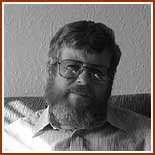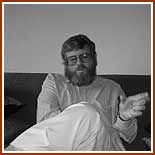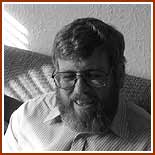 |
|
 "We were looking at the forest as a resource in '39. We saw the consequence of ignoring the environment we were living in."  "They wouldn't have had television or faxes. The only warning they had would have been seeing the smoke."  "People talk about how this was an act of God, there was never anything like it, it was a freak accident. But they are quite explainable."  "Canberra wasn't a worst case scenario. The Dandenongs are just waiting to go up. It's a bonfire, just waiting to go. We could cast a big mat around Melbourne."  "People in the cities aren't immune to the effects of bush fires. I've seen it before in '39. The only difference now is that Melbourne has a population of four million instead of half a million." |
Kevin Tolhurst Fire ecologist based at University of Melbourne, Creswick Campus. 
In more recent times I've been shifting more towards looking at fire behaviour and fire management, rather than the fire ecology side of things. My interest is largely to do with risk management. If we can pull together the sciences of fire behaviour, fire suppression and fire ecology, that will be a really useful tool. It will help us weigh up some of the priorities we have. Allocating resources to big red fire trucks, or to ecological management, or to public education and awareness and assistance. A lot of our fire behaviour knowledge has come from a legacy left by Alan McArthur. We still use his fire danger meter as the basic fire danger rating system across Australia. Since McArthur's work in the 40s, 50s, 60s and 70s, we've lost a lot of understanding of where all that information comes from. I still use the McArthur fire behaviour system, whether I'm working in Mallee environments, in mountain forest, foothill forests or footlands, because I understand where the model has come from. I've been able to adapt it to the current conditions, the current environment, and it still works quite well. The principles that it's based on work. It looks at four considerations: what influence topography is having in the role of fire behaviour, what role the fuels are playing, what role the weather is playing and what role the fire itself is playing. If you understand those four principles, and then see how the scale of the fire is changing, then McArthur's system works just as well. With the use of computers today, in fire science or anywhere else, people get an answer to 12 decimal places and think, well, this is very precise. But they don't realise the answer they have is only as good as the information they've put into it. A lot of what I've been doing in my career is countering the hype of the technology and saying, "What we need is better input information and better intelligence". There is no point having a gee whiz fire behaviour model if we can't get good fire weather information, good local fuel topography information, if we can't get all of that basic information together. The impact that a fire will have on an environment is determined by a few factors. How intense the fire is, when it occurs, how large it is, how patchy it is, and what sort of fuel has been burned in it. From the ecological viewpoint, you look at the old Greek thing - earth, air, fire and water. Fire is once of the essential elements of our environment, and there is no way we can get rid of it. So if that's the case, then we've got to learn to live with it. Where there are enough sources of ignition, whether from lightening, human activity, geological activity like volcanos - if you've got the right fuel and the right weather conditions, you'll get fires occurring. The '39 fires were important because there was a conjunction of a whole lot of things. One was the fact that in the period of pioneering, fire was almost ignored in a sense. It was used for clearing up and to operate steam engines and so on. But it wasn't actually used as part of the environment. We weren't looking at the forest as an ecosystem, we were looking at it as a resource, either for timber or as an agricultural source, It was the wrong mindset to be managing a fire. So to a large extent, in '39 we saw the consequence of ignoring the environment we were living in. We also hadn't taken enough notice of the fact that the seasonal conditions were building up to a bad fire situation.  There were drought conditions, the bush was drying out, and people sort of recognised it, but didn't respond to it. There had been bad fires since about August 1938, and it was building. By January '39, there were hundreds of fires burning in the forests, basically unabated. There were drought conditions, the bush was drying out, and people sort of recognised it, but didn't respond to it. There had been bad fires since about August 1938, and it was building. By January '39, there were hundreds of fires burning in the forests, basically unabated.When the weather conditions got bad, the fuel was ready and available because of the drought. The fires were than able to get a run on and joined up, and that convergence was well in excess of what humans could cope with, in terms of controlling that fire. I think that mindset of the '39 fires is still largely there today. We're becoming more and more urbanised, and as such we don't really appreciate what makes our ecosystems work. Whether it is forests or aquatic systems, or heathlands or alpine areas, people just drive out along the bitumen road down to the national park or forest and expect it to be there. There is no appreciation that this is a dynamic system that actually needs to be under some sort of management. One of the things that has impressed me a lot is the records of what the Europeans found when they came to Australia. The Australian landscape was largely a fire-managed landscape, and it was managed by the Aboriginal people. They practised very careful burning around high-value assets, like a camping area or a fishing area. Later in the season there would be some very large fires lit for chasing out game and so on. It wasn't in the same way we would do it today, writing a management plan and so on, but they saw what the problem was and they were responding to it. One of the most difficult things to get across to a lot of land managers these days is the importance of monitoring, and carefully responding to what we see is happening. We can learn a lot about this from the Aborigines. Science should give us an advantage, but in the end you have to come back to understanding what is happening locally, on the ground. We have to know why it is that down in this valley, we get a different response to fire than we get over in the next valley. It could be because of the way the wind blows through the valley, or because it's a rain shadow. Of course, as the fire expands people at state and regional levels have to be able to work with that big picture. But they can only do so if they are getting good information from the local level. The people at the local level need to have enough power to be able to work locally. That's what the chief fire officer is for, is to facilitate that and make sure it happens. If you look at the fires we've had this last summer, when it comes to suppressing the fire, it doesn't matter how nice the map is or the kind of strategy you might have on it. In the end, the effectiveness of the operation will depend on how well a crew is working on their line. It doesn't matter how good your strategy or your general support is, in the end what's important is the implementation of that strategy on the ground, and that has got to be a local decision. A few things were different in '39. One is that there were a lot of people actually living in the bush, because of the timber industry in particular, and so immediately people were in a more dangerous and more hazardous environment. There was also much poorer communication. They wouldn't have had television, faxes and so on. The only communication they had would have been seeing the smoke, to let them know how close the fire was. When the scale of a fire changes, the level of communication needs to change as well. It's no longer relevant just to have good communication just within your community. To understand the broader picture it needs to be from community to community.  In the recent fires, one of the most important things was ABC radio. It's fairly widely broadcast and regular updates were something that were successful for most people. I spent a little bit of time up in a place called Deddick Valley, and they felt quite disadvantaged because they couldn't get ABC radio. In the recent fires, one of the most important things was ABC radio. It's fairly widely broadcast and regular updates were something that were successful for most people. I spent a little bit of time up in a place called Deddick Valley, and they felt quite disadvantaged because they couldn't get ABC radio.So we've gone from a situation in '39 where people expected to be self reliant, to an expectation in 2003 where people expected to be fed information. With the level of preparation we have now, at least it wasn't such a big surprise when the fire actually came down on them. I mean, it was still horrific, but at least they were mentally and physically prepared. I think that was a great difference between '39 and 2003. Also, in 1939, many individuals hadn't been exposed to that scale of fire before. I continually hear people talk about how this was an act of God, there was never anything like it, it was a freak accident, and so on. But they are not freak things, they are quite explainable. It's just in the experience of that individual that it's been something quite extraordinary. In 2003 there were about four fire fronts about 10-20 km wide across the high plains of the divide. In 1939 there were hundreds of fires, and fire fronts basically going across the whole state. On top of that, there had been a lot of timber-getting and clearing, so there was a lot of fuel. All the openings, where the forest had been partially cleared, provided little accelerator buttons to the fire. The wind gets in, it's dry, and there is more than one fuel because of the logging slash, so rather than getting a more even run of fire, you get these big flare-ups. In '39 about 70 per cent of the mountain ash forest was burned. In 2003 it was a different sort of environment. A lot of alpine ash got burnt, but not much mountain ash. There were some significant changes to legislation as a result of the '39 fires. All the sawmills were pulled out of the forest, and there were much more stringent restrictions put on how sawdust was burnt around sawmills. The impetus for the CFA began out of a sort of threatening inquiry, and it was basically sealed after the '44 fires. It was an enormous advance in fire management from a protection view. Stretton's recommendations in the royal commission were all about establishing a control mechanism. What he was proposing went a long way, but his vision didn't go far enough. From 1939 we learned that we need to be more careful about our business, how we do our housekeeping, how we look after burning the bush, how we control fires, how we manage our timber industry, how we set up our towns, how we organise our resources. It didn't teach us that we need to manage fire in the landscape as well. We still don't have coherent legislation now that requires us to manage fire in an ecologically and environmentally sustainable way. Now it's more about just the protection of human life and property. What we haven't learned, is how do we actually prevent these abnormal, unnatural fires from spreading across the landscape. We still haven't adequately learned that lesson from the Aboriginal use of fire. Melbourne has two major problems. One is the urban interface, and the other is the water catchment. Melbourne has a significant rural-urban interface, where we see places like Kinglake, St Andrews, the Dandenongs, Pakenham. People like the natural environment, so they want to live close to it, but they are living an urban existence. They are not dependent on that bush, and they don't fully understand it.  I think in '39 the people living and working in the bush knew much more about their environment and what they were dealing with. Okay, they didn't have scale and they didn't have communication, but at least they understood the bush. I think in '39 the people living and working in the bush knew much more about their environment and what they were dealing with. Okay, they didn't have scale and they didn't have communication, but at least they understood the bush.We really need to do to understand the bush. Appreciating it is not enough. The worst case scenario for these people is loss of property and loss of life. Canberra wasn't a worst case scenario. I think there is potentially much worse. The Dandenongs are just waiting to go up. It's a bonfire, just waiting to go. We could cast a big mat around Melbourne. The other thing about 2003 is that we largely had only one fire. If we had fires up in the Grampians, in the south-west of the state and in the Otways, and we had fires around Melbourne as well as down east, it would have been much more difficult for us. So what is the solution? It is not fire suppression forces. It's empowering people to look after their own welfare, from a human life and property point of view, and also better management of fire in the landscape by the land management agencies. People in the cities aren't immune to the effects of bush fires. One thing that no one can live without is water, and the biggest effect the fire is going to have on people in an urban environment is on their water supply. We shouldn't underestimate that impact. There would be an impact on communications, power supply, primary production and so on, but the biggest single impact would be the impact on water, if the catchments get affected. I've seen it before in '39. The only difference now is that Melbourne has a population of four million instead of half a million. People need to come to terms with the fact that fire has been part of our environment for millions of years, and needs to continue to be part of our environment. If they do so, then they should be able to realise that the use of fire as a land management tool is essential and not an option. Complaints about smoke spoiling the view and so on, really should pale into insignificance in comparison with the impact that bushfires can have at a social, economic or environmental level. Read more about how Victorian bushfires threaten Melbourne’s water supply |
The Scientists
Bill Wright
Climatologist Bureau of Meteorology David Packham Fire Managment Consultant, Indonesia David Ashton Doctor of Science, expert on the mountain ash forests Mike Reeder Reader in Applied Mathematics at Monash University. Kevin Tolhurst Fire ecologist based at University of Melbourne, Creswick Campus |
 |